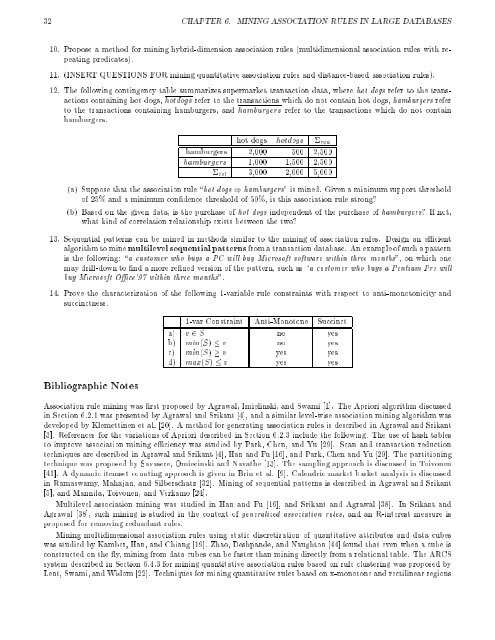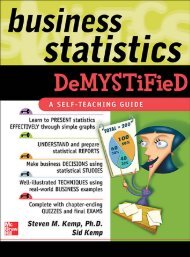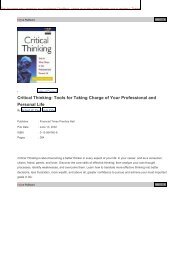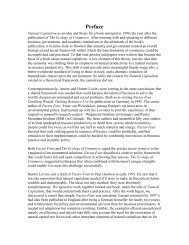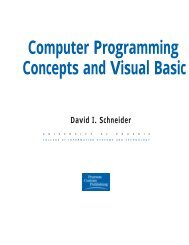Chapter 06 - Changing Education Paradigm
Chapter 06 - Changing Education Paradigm
Chapter 06 - Changing Education Paradigm
You also want an ePaper? Increase the reach of your titles
YUMPU automatically turns print PDFs into web optimized ePapers that Google loves.
32 CHAPTER 6. MINING ASSOCIATION RULES IN LARGE DATABASES<br />
10. Propose a method for mining hybrid-dimension association rules (multidimensional association rules with repeating<br />
predicates).<br />
11. (INSERT QUESTIONS FOR mining quantitative association rules and distance-based association rules).<br />
12. The following contingency table summarizes supermarket transaction data, where hot dogs refer to the transactions<br />
containing hot dogs, hotdogs refer to the transactions which do not contain hot dogs, hamburgers refer<br />
to the transactions containing hamburgers, and hamburgers refer to the transactions which do not contain<br />
hamburgers.<br />
hot dogs hotdogs row<br />
hamburgers 2,000 500 2,500<br />
hamburgers 1,000 1,500 2,500<br />
col 3,000 2,000 5,000<br />
(a) Suppose that the association rule \hot dogs ) hamburgers" is mined. Given a minimum support threshold<br />
of 25% and a minimum con dence threshold of 50%, is this association rule strong?<br />
(b) Based on the given data, is the purchase of hot dogs independent of the purchase of hamburgers? If not,<br />
what kind of correlation relationship exists between the two?<br />
13. Sequential patterns can be mined in methods similar to the mining of association rules. Design an e cient<br />
algorithm to mine multilevel sequential patterns from a transaction database. An example of such a pattern<br />
is the following: \a customer who buys a PC will buy Microsoft software within three months", on which one<br />
may drill-down to nd a more re ned version of the pattern, such as\a customer who buys a Pentium Pro will<br />
buy Microsoft O ce'97 within three months".<br />
14. Prove the characterization of the following 1-variable rule constraints with respect to anti-monotonicity and<br />
succinctness.<br />
Bibliographic Notes<br />
1-var Constraint Anti-Monotone Succinct<br />
a) v 2 S no yes<br />
b) min(S) v no yes<br />
c) min(S) v yes yes<br />
d) max(S) v yes yes<br />
Association rule mining was rst proposed by Agrawal, Imielinski, and Swami [1]. The Apriori algorithm discussed<br />
in Section 6.2.1 was presented by Agrawal and Srikant [4], and a similar level-wise association mining algorithm was<br />
developed by Klemettinen et al. [20]. A method for generating association rules is described in Agrawal and Srikant<br />
[3]. References for the variations of Apriori described in Section 6.2.3 include the following. The use of hash tables<br />
to improve association mining e ciency was studied by Park, Chen, and Yu [29]. Scan and transaction reduction<br />
techniques are described in Agrawal and Srikant [4], Han and Fu [16], and Park, Chen and Yu [29]. The partitioning<br />
technique was proposed by Savasere, Omiecinski and Navathe [33]. The sampling approach is discussed in Toivonen<br />
[41]. A dynamic itemset counting approach isgiven in Brin et al. [9]. Calendric market basket analysis is discussed<br />
in Ramaswamy, Mahajan, and Silberschatz [32]. Mining of sequential patterns is described in Agrawal and Srikant<br />
[5], and Mannila, Toivonen, and Verkamo [24].<br />
Multilevel association mining was studied in Han and Fu [16], and Srikant and Agrawal [38]. In Srikant and<br />
Agrawal [38], such mining is studied in the context of generalized association rules, and an R-interest measure is<br />
proposed for removing redundant rules.<br />
Mining multidimensional association rules using static discretization of quantitative attributes and data cubes<br />
was studied by Kamber, Han, and Chiang [19]. Zhao, Deshpande, and Naughton [44] found that even when a cube is<br />
constructed on the y, mining from data cubes can be faster than mining directly from a relational table. The ARCS<br />
system described in Section 6.4.3 for mining quantitative association rules based on rule clustering was proposed by<br />
Lent, Swami, and Widom [22]. Techniques for mining quantitative rules based on x-monotone and rectilinear regions


